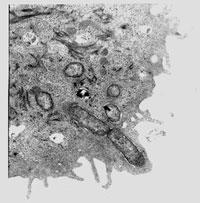Why are genetic mutations produced?
2001/02/09 Mendiburu, Joana - Elhuyar Zientziaren Komunikazioa
In this time when the genetic code of the different organisms is described, the researchers have placed special emphasis on how to organize genetic information in the nucleus of eukaryotic cells. In eukaryotic cells, within the nucleus of the nuclear membrane, genetic material is a nucleoprotein complex (chromatine) not randomly separated. This spatial location may have great importance in genome activity, but it is still not very clear what conditions. However, as published in the journal Nature Cell Biology in February 2001, at the Curie Institute, a group of the National Center for Scientific Research (CNRS) has made a new path to know how DNA is organized in the nucleus.
Schematically, the cell nucleus can be divided into two zones: heterochromatine and eucromatine. Heterochromatine is mainly composed of non-coding DNA sequence repeats and is characterized by the presence of subacetylated histones. Histones are proteins that when binding to DNA produce nucleosomas (fundamental unit of chromatin).
There are many changes in histone tips and the most studied change has been that of acetylation. The degree of acetylation is regulated by two families of enzymes: acetyltranferous histones add to histones a group of acetylene and histones desacetylates remove a group of acetylene. The first enzymes are also coactivators of transcription.
So far, the role of heterochromatine zones in mammals was to be defined, although it was considered of great importance in chromosomal separation.
In this new research, the degree of acetylene of histones has been modified, inhibiting the enzymes histone desacetylase. In this way, they have realized that, changing the degree of acetylation, the zones of heterochromatine are located in the periphery of the nucleus and lose their capacity of association with the protein HP1. In fact, HP1 proteins localize macromolecular complexes in chromatin. These changes cause failures in the separation of chromosomes. Thanks to this new study, it has been shown the importance of controlling the level of acetylene in the areas of heterochromatine of the nucleus for correct generational genetic transmission. In fact, subacetylation directly influences the location of histones, the association with HP1 proteins and the separation of chromosomes.

Gai honi buruzko eduki gehiago
Elhuyarrek garatutako teknologia




